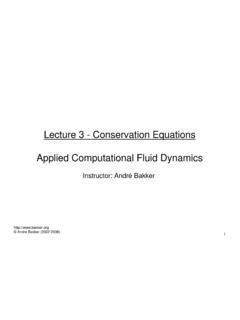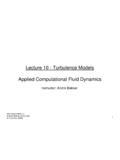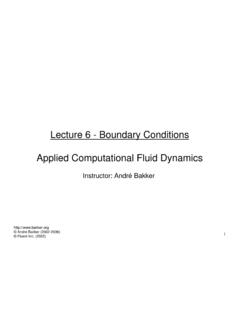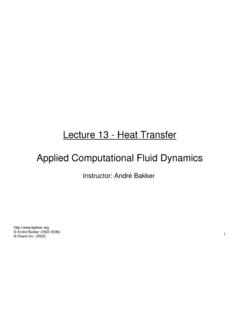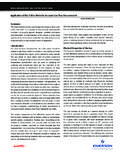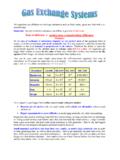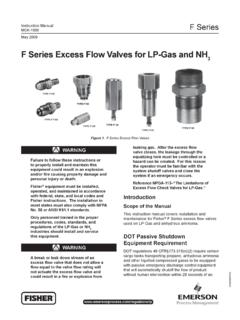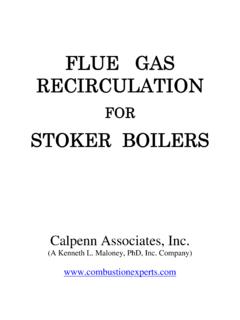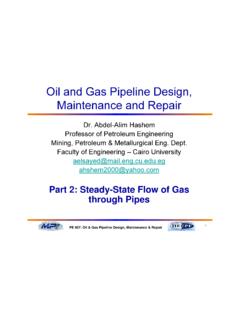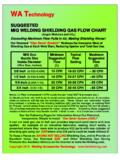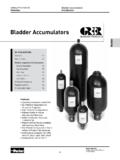Transcription of Lecture 14 - Multiphase Flows Applied Computational Fluid ...
1 1 Lecture 14 - Multiphase FlowsApplied Computational Fluid DynamicsInstructor: Andr Andr Bakker (2002-2006) Fluent Inc. (2002)2 Definitions Multiphase flow is simultaneous flow of: Materials with different states or phases ( gas, liquid or solid). Materials with different chemical properties but in the same state or phase ( liquid-liquid systems such as oil droplets in water). The primary and secondary phases: One of the phases is continuous (primary) while theother(s) (secondary) are dispersed within the continuous phase. A diameter has to be assigned for each secondary phase to calculate its interaction (drag) with the primary phase.
2 A secondary phase with a particle size distribution is modeled by assigning a separate phase for each particle Dilute versus dense phase: Refers to the volume fraction of secondary phase(s). Volume fraction of a phase = Laminar versus turbulent: Each phase can be laminar or turbulent. Fluid flow (primary phase) may be turbulent with respect to the secondary phase but may be laminar with respect to the of the phase in a cell/domainVolume of the cell/domainDefinitions (2)4 Why model Multiphase flow? Multiphase flow is important in many industrial processes: Riser reactors. Bubble column reactors. Fluidized bed reactors. Scrubbers, dryers, etc.
3 Typical objectives of a modeling analysis: Maximize the contact between the different phases, typically different chemical compounds. Flow CD-6 BT-65bubbly flow droplet flow particle-laden flowslug flowannular flowfree-surface flowMultiphase flow regimes Bubbly flow: discrete gaseous bubbles in a continuous liquid. Droplet flow: discrete Fluid droplets in a continuous gas. Particle-laden flow: discrete solid particles in a continuous Fluid . Slug flow: large bubbles in a continuous liquid. Annular flow: continuous liquid along walls, gas in core. Stratified and free-surface flow: immiscible fluids separated by a clearly-defined regimes: vertical gas-liquid flow)()/()/(:23mAsmQsmvVelocitylSuperfic iasg=)()/(60)(33mVsmQVVMQ=Evaporator7 Multiphase flow regimes User must know a priori the characteristics of the flow.
4 Flow regime, bubbly flow, slug flow, annular flow, etc. Only model one flow regime at a time. Predicting the transition from one regime to another possible only if the flow regimes can be predicted by the same model. This is not always the case. Laminar or turbulent. Dilute or dense. Secondary phase diameter for drag Empirical correlations. Lagrangian. Track individual point particles. Particles do not interact. Algebraic slip model. Dispersed phase in a continuous phase. Solve one momentum equation for the mixture. Two-fluids theory (multi-fluids). Eulerian models. Solve as many momentum equations as there are phases. Discrete element method.
5 Solve the trajectories of individual objects and their collisions, inside a continuous phase. Fully resolved and complexityModeling approach9 Coupling between phases One-way coupling: Fluid phase influences particulate phase via aerodynamic drag and turbulence transfer. No influence of particulate phase on the gas phase. Two-way coupling: Fluid phase influences particulate phase via aerodynamic drag and turbulence transfer. Particulate phase reduces mean momentum and turbulent kinetic energy in Fluid phase. Four-way coupling: Includes all two-way coupling. Particle-particle collisions create particle pressure and viscous Multiphase flowsFlow Specificbubblydropletparticle-ladensluga nnularstratified/free surfacerapid granular flowModel SpecificLagrangian Dispersed Phase Algebraic SlipEulerianEulerian GranularVolume of Fluid ?
6 Process SpecificSeparationFiltrationSuspensionEv aporationReaction What is the goal of the simulation? Which effects are important? Controlled by which hydrodynamic effects? Controlled by which other transport phenomena effects? All these factors influence which model to choose for the effects in dispersed systems Hydrodynamics: Change in shape. Diameter. Particle-wall collision. Particle-particle collision. Coalescence. Dispersion and breakup. Turbulence. Inversion. Other transport phenomena: Heat transfer. Mass transfer. Change in composition. Heterogeneous 182=24/Re101 Hydrodynamics: particle relaxation time When does the particle follow the flow?
7 Time when particle reaches about 60% of the initial difference = 13 Hydrodynamics: particle relaxation timedp p g pCoal combustion1-500 600-20002E-5 Pa E-6 sBubble columns1-5 mm11E-3 Pa mm20002E-5 Pa 140 mm20001E-3 Pa s1E-3 sgpppd 182=Typical relaxation times in process applications14 Multiphase formulation Two phases Three phasesFluidSolidsSolids - 1 Solids - 2 FluidModel overview Eulerian/Lagrangian dispersed phase model (DPM). All particle relaxation times. Particle-wall interaction always taken into account, particle-particle usually not. Algebraic Slip Mixture Model (ASM). Particle relaxation times < - s.
8 Neither particle-wall interaction nor particle-particle are taken into account. Eulerian-Eulerian model (EEM). All particle relaxation times. Particle-wall interaction taken into account, particle-particle usually not. Eulerian-granular model (EGM). All particle relaxation times. Both particle-wall and particle-particle interaction are taken into account. 16 Algebraic slip model (ASM) Solves one set of momentum equations for the mass averaged velocity and tracks volume fraction of each Fluid throughout domain. Assumes an empirically derived relation for the relative velocity of the phases. For turbulent Flows , single set of turbulence transport equations solved.
9 This approach works well for flow fields where both phases generally flow in the same Solves one equation for continuity of the mixture: Solves for the transport of volume fraction of one phase: Solves one equation for the momentum of the mixture:rjkrikknkkijjmijmjimeffijjmimmij muuxFgxuxuxxPuuxut,,1,,,,,)()( =+++++ =+0)(=+iixut 02,2=+iimxut ASM equations18 Average density: Mass weighted average velocity: Velocity and density of each phase: Drift velocity: Effective viscosity:2211 +=m2211222111 u u um++=rrr21,21,, uurrmruuurrr =112211 +=effASM equations (2)19 Uses an empirical correlation to calculate the slip velocity between phases.
10 Fdragis the drag rr== ))((tuuugammm + =rrrrrdragfppmpfd 18)(2 = > += velocity and drag20 Applicable to low particle relaxation times < - One continuous phase and one dispersed phase. No interaction inside dispersed phase. One velocity field can be used to describe both phases. No countercurrent flow. No 18)(2 =Restrictions212 < L/D < 20UG,supup to 50 cm/sUG,sup>> UL,supLiquidGasGas InletLiquid/Slurry InletGasLiquid PoolSpargerA bubble column is a liquid pool sparged by a process : bubble column design22 Flow Regime Map (Deckwer, 1980)Bubbly FlowChurn-Turbulent Flow ( Heterogeneous )Bubble columns: flow regimes23 Bubble column design issues Design parameters: Gas holdup.
